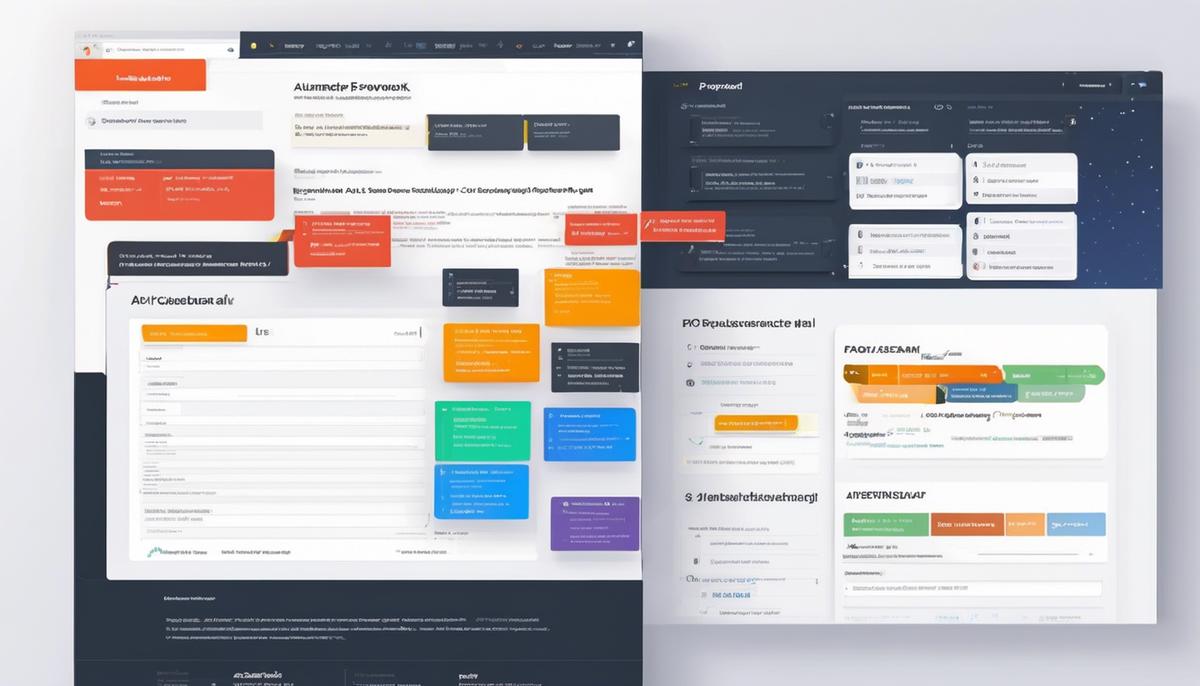Welcome to a deep dive into FastAPI, a modern, high-performance web framework for Python that’s vying for its well-deserved place in the limelight. Known for its impressive performance, almost equivalent to that of NodeJS or Go, FastAPI is combining top-notch features and attracting web developers from all over the world. From the ins and outs of this framework to building APIs, authentication, and even its enormous impact in the field of data science, this exploration promises a comprehensive understanding of FastAPI. Not stopping just at that, we also connect FastAPI’s effectiveness with global best practices employed by big market players like Netflix, Microsoft, and Uber. This journey through the workings of FastAPI promises to be much more than just a theoretical overview, it is a hands-on guide that will enable you to master this game-changing tool.
Introduction to FastAPI
Unveiling FastAPI: A Rising Star in the Pantheon of Web Frameworks
Among the wide spectrum of web frameworks that tech aficionados have at their disposal, FastAPI stands out with its exceptional speed, standardization, and user-friendly nature. It’s no surprise that this modern, fast (high-performance), web framework, essentially built for building APIs with Python 3.6+ types hints, has garnered significant attention from developers around the globe. But what exactly sets FastAPI apart from its contemporaries?
FastAPI seizes the spotlight mainly for its tremendous speed. Running on Starlette for the web parts and Pydantic for data validation, FastAPI has comparable performance to NodeJS and Go, far outstripping frameworks created traditionally on Python. With less code and more functionality, it aligns perfectly with the requirements of developers in high throughput scenarios.
In the landscape of modern tech behavior where programmers are enamored with automating tasks to heighten productivity, FastAPI offers some compelling features. The automatic interactive API documentation is one such perk. When defining the routes with FastAPI, an automatic, interactive API documentation is created on the fly. This immensely speeds up the process of understanding and testing the web application.
Moreover, FastAPI combines the best aspects of what frameworks such as Flask and Django offer with the full-fledged capabilities of data validation using Pydantic. This enables developers to use Python type hints, ensuring the most efficient error handling and request parameter validation styles. This unique feature translates into potential savings of hundreds of hours in developer time, which would normally be spent debugging, determining data issues, and writing validation code.
Arguably, FastAPI’s defining benefit is its superior standardization. With the framework, developers can achieve an OpenAPI and JSON schema standardization automatically. No more hurdles of using third-party libraries for making it compatible with Swagger, FastAPI takes care of it. Among other things, this makes collaboration easier, ensures flexibility, and provides developers an industry standard for building REST APIs.
Furthermore, FastAPI borrows the dependency injection system from Starlette that developers seem to rave about. Written from the ground up to be easy to use and intuitive, the framework ensures that less experienced developers can efficiently exploit the asynchronous capabilities offered by Python’s asyncio library.
In conclusion, the revolutionary FastAPI has rightly caught the fascination of many due to its speed, auto document generation, state-of-the-art error handling, and superior standardization features. It takes modern Python to the next level, providing a comprehensive and effective approach to web development in a smooth, streamlined, and automation-friendly manner. The weave of all these features ensures that FastAPI is not just another name in the realm of web frameworks but a top-notch choice for developers to embrace.

Building Web APIs with FastAPI
Constructing Efficient Web APIs using FastAPI
Developing web applications often involves creating efficacious APIs to allow the application to communicate with other software. Choosing the appropriate technology to facilitate this communication and ensure a responsive and optimized application doesn’t have to be arduous. FastAPI is a modern, high-performing Python web framework for creating APIs that is rapidly gaining popularity in the tech community. The power of FastAPI lies not in its breakneck speed, a comparison drawn with other Python frameworks, but in its application to construct web APIs. So how, exactly, is this done?
Building APIs with FastAPI begins, as with any development project, with setting up the environment. This requires first installing Python and then FastAPI itself, as well as an asynchronous server gateway interface (ASGI), such as Uvicorn or Hypercorn. Then, by creating a new Python file and importing FastAPI, the structure of the API begins to take shape.
FastAPI uses a straightforward syntax for defining routes: decorators highlight the HTTP method and path, while the function beneath the decorator serves as the endpoint. The Python type annotations you assign to function arguments will govern how data is parsed from requests, converting the data into the indicated type automatically. This efficient use of Python’s native functionality both reduces the developer’s load and ensures data integrity.
Moreover, FastAPI integrates seamlessly with Pydantic models, a key feature differentiating it from other Python frameworks. This combination allows for advanced features such as data validation, serialization, and documentation all in one. Via these models, one can define how data should be received in a POST request; the model is then used as a parameter in a route function. FastAPI, in turn, validates incoming requests against the Pydantic model and automates error messaging for aberrations.
For asynchronous capabilities, FastAPI incorporates Starlette’s dependency injection system. It navigates dependencies at run time, without any need for manual setup. By indicating async def instead of simple def, one creates asynchronous endpoints. While it may appear small, this addition prepares your API for handling requests simultaneously, without waiting for previous tasks to complete. It enhances the throughput of the API by making it capable of multitasking.
Do more with less. This could be the mantra for FastAPI, and the tech world is sitting up and taking serious notice. The coupling of innovative speed and performance features with an impressively user-friendly interface positions FastAPI as an invaluable tool for API development.
Pushing the boundaries and embracing optimal technology drives progress in the tech industry. Automation, standardization, and efficiency are not just marketing buzzwords; they’re essential elements toward shaping the future of web development. Ever evolving, FastAPI is leading that charge as more and more developers choose it for building efficient and responsive APIs. It might be worth taking note.

Authentication and Authorization in FastAPI
Securing APIs in FastAPI Using Inherent Functionalities
After delving deep into the high-level performance and functionalities of FastAPI, setting up a development environment, and understanding its syntax and structure, it’s now essential to address a concern that’s pivotal in the modern digital space. Irrespective of any framework’s capabilities, if it fails to provide robust security, its utility significantly diminishes. In the case of FastAPI, developers can feel confident about robust security measures available to ensure secure APIs.
Employing OAuth2 and JSON Web Tokens (JWT)
FastAPI allows the utilization of an open standard for secure access delegation, OAuth2. It is vital for authentication and authorization in APIs. Through the use of JSON Web Tokens (JWT), a compact, URL-safe means of representing claims securely between parties, FastAPI eases implementation of OAuth2. Thus, it ensures secure, standardized data transmission in APIs.
HTTPBasicCredentials for User Authentication
FastAPI’s ‘HTTPBasicCredentials‘ — part of a ‘security‘ module that helps developers handle the authentication process, mainly using a username/password schema. This utility extraction function ensures that HTTP Basic Access Authentication is inherently secure and easy to use.
API Key Authentication – An Extra Layer
FastAPI also incorporates support for API Key authentication, providing an extra layer of security. Whether passed as a part of the URL or as a request header, FastAPI offers the flexibility to choose how the API key is to be received. The API key verification function verifies and validates the API key, significantly decreasing the possibility of unauthorized access.
Response Model’s Inherent Role in API Security
FastAPI facilitates the use of ‘response_model‘ to limit, mask, or transform the data delivered by APIs. This feature ensures that only predefined, desired data is sent, protecting sensitive data from accidental exposure.
Dependable Dependency Injection
The Starlette’s dependency injection system features the ability to declare ‘dependencies‘ – de facto functions that create values. They act as dependencies for other routes and functions. Explicit dependency declaration supports better control over security protocols and ensures resources are utilized securely.
Advancements like FastAPI, which combine speed, performance, and usability with stringent security features, are precisely what developers need in this era of rapid digitization. While its exceptional capabilities make FastAPI a worthy tool for API development, the inherent functionalities to secure APIs make it an even more advantageous addition to any tech enthusiast’s toolkit.
Reliable and secure, FastAPI is bringing much-needed peace of mind to the ever-evolving tech scene. The control, choice, and flexibility it gives to developers have raised the bar for web development security.
FastAPI for Data Science
FastAPI is a game-changer for data science operations, primarily due to its seamless efficiency.
The excellent speed and performance of FastAPI have a direct application in data science operations.
It highly accelerates the operations, especially in parsing and handling big data.
The framework allows asynchronous request handling, making data processing, particularly involving large datasets, simpler and quicker.
We have seen FastAPI’s competency in web development, but when incorporated into data science operations, it sparks newfound productivity.
The data validation with Pydantic models not only ensures consistency of data but also escalates the speed at which data is cleaned and structured for further operations in data science.
This eliminates the colossal time and manual effort required in data preprocessing.
FastAPI implements OAuth2 and JSON Web Tokens (JWT) for security which authenticate and protect the data, making it an ideal choice for data science operations where data confidentiality is critical.
With HTTPBasicCredentials, it becomes possible to keep track of users and their activities in real time, providing essential insights for customer or user-based data analytics.
API Key Authentication reinforces the security framework by ensuring specific access and avoiding unauthorized breaches.
In data science, presenting the results in an understandable format is as important as performing complicated computations.
FastAPI shines here too, with the response model playing an intrinsic role in bolstering API security and shaping the output data structure to be more legible and useful for end users.
The FastAPI framework can handle several response models, which is significant since data science operations often yield results that need to be interpreted differently based on the context.
Lastly, FastAPI’s dependency injection system used for asynchronous capabilities in web development is efficiently applicable in data science operations.
Being able to automatically manage and inject required dependencies makes the tasks more manageable, reducing the probability of errors and improving data procession efficiency.
To conclude, FastAPI is a dynamic framework with powerful implications for data science.
Its potent combination of speed, data validation features, integrated security mechanisms, and the capability to represent results in user-friendly formats makes it an immense catalyst for successful, effective, and efficient data science operations.
Best Practices and Use Cases
Shifting the focus onto real-world use cases and best practices, it’s worth noting that FastAPI has seen grand-scale applications in industries such as finance, healthcare, and data science due to its exceptional features.
One of the standout applications of FastAPI has been in the Financial Technology sector where timing and accuracy are critical. FastAPI’s performance, along with Pydantic’s robust data validation, offers a substantial improvement over traditional rest APIs for fintech software development. FastAPI’s speedy interpretation and data validation have accelerated the processing of financial transactions and overall system efficiency, ensuring the accuracy of data and speedy resolution of fintech related queries.
Furthermore, top-tier financial institutions have leveraged the asynchronous request handling capabilities offered by FastAPI to handle voluminous data with ease, striving towards real-time analytics for decision making. Its dynamic, automatic interactive API documentation decreases debugging time significantly and improves the speed of software delivery.
On the healthcare front, FastAPI is favored due to its facilitation of rapid execution of complex calculations with a fraction of usual memory overhead. The health care sector has used FastAPI to improve decision-making processes and aid in data-intensive functions like disease prediction models, optimizing patient treatment plans, and managing patient data.
FastAPI’s integration with Pydantic aids in structuring and verifying large amounts of health data – a necessity in the healthcare sector. This Burgeoning industry relies on FastAPI’s built-in OAuth2 and JSON Web Token (JWT) support and HTTP Basic Credentials for securing patient data and implementing Health Insurance Portability and Accountability Act (HIPAA) compliant systems.
When it comes to data science operations, FastAPI’s asynchronous capabilities excel in handling large volumes of requests concurrently. Its compatibility with WebSocket and HTTP/2 increases the rate at which data scientist can make real-time predictions. FastAPI’s use of dependencies for encapsulating reusable code, managing shared resources, and fulfilling other auxiliary tasks, aids in efficient time management and scalable code.
The relationship between FastAPI’s ResponseModel and data security cannot be overlooked. In developing applications that deal with sensitive data, such as user-oriented services or internal enterprise applications, it’s a best-practice to leverage ResponseModel capabilities to redact certain data fields, refining what exactly is sent back to the client.
To conclude, the adoption of FastAPI has seen an upward trajectory from simple use-cases to complex applications. Its versatility, combined with its speed and standardization, has made it an excellent choice for technologists looking to build efficient, scalable, and user-friendly applications.
Through this exploration, our understanding of FastAPI has been enriched, underlining how its blend of advanced features like Python 3.6 typing, asyncio, and Starlette make it an indispensable tool in web development. We unraveled the steps of creating effective web APIs with FastAPI, covered the intricacies of authentication and authorization and dived deep into its potential in the realm of data science. We also highlighted its practical applications, citing best practices and use cases from some of the world’s largest tech giants. All in all, our journey emphasizes that FastAPI is not only an impressive tool for Python developers but holds great promise for enthusiasts or hobbyists willing to break the barriers of the possible.
Experience the powerful AI content writer, Writio, crafting impeccable articles for websites. This page was skillfully written by Writio.



